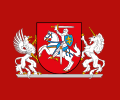President_of_the_Republic_of_Lithuania
President of Lithuania
Head of state of the Republic of Lithuania
The president of the Republic of Lithuania (Lithuanian: Lietuvos Respublikos Prezidentas) is the head of state of Lithuania. The president directs and appoints the executive branch of the Government of the Republic of Lithuania, represents the nation internationally and is the commander-in-chief of the Lithuanian Armed Forces. The president is directly elected by the citizens of Lithuania for a five-year term, with the office holder limited to serving two terms consecutively. The current president is Gitanas Nausėda who assumed office on July 12, 2019.
You can help expand this article with text translated from the corresponding article in Lithuanian. (September 2021) Click [show] for important translation instructions.
|


